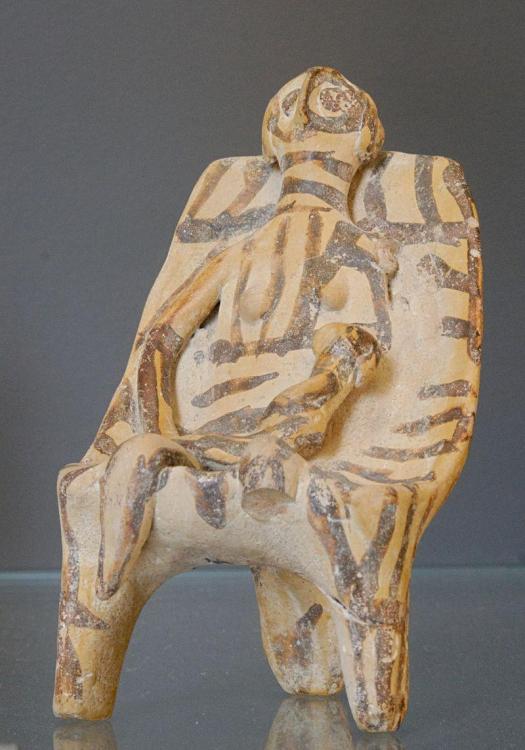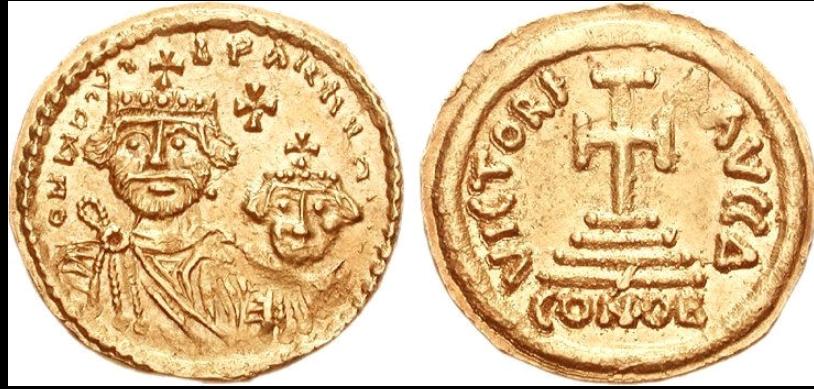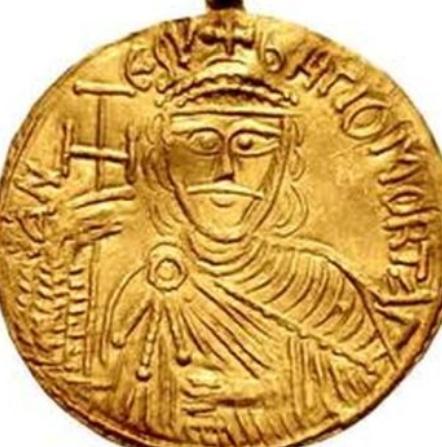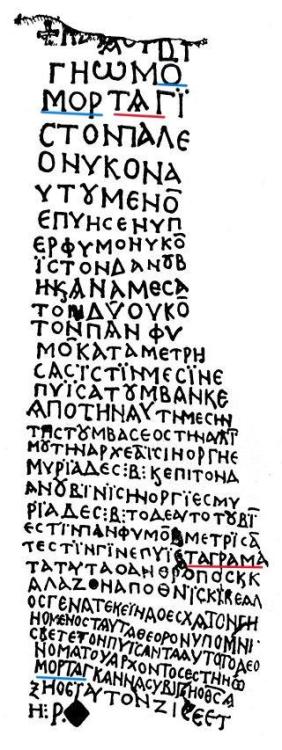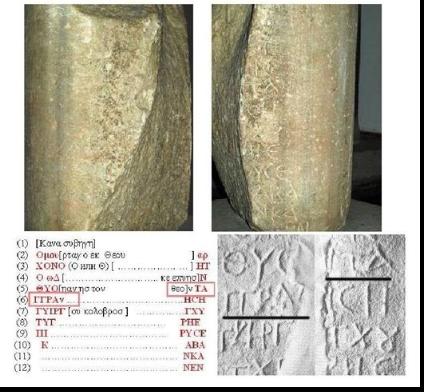
Tomata
Потребител-
Брой отговори
1296 -
Регистрация
-
Последен вход
-
Days Won
1
Content Type
Профили
Форуми
Библиотека
Articles
Блогове
ВСИЧКО ПУБЛИКУВАНО ОТ Tomata
-
Интересна дискусия се е заформила.. Липсват само масагетите (мизо-гети)->Юеджи+хунну->Вархони–>авари+хуни.. С най-грубо приближение, снежната топка значи се е търкаляла на изток, от нея се пръкват разни хуни, тохари и т.н. После отново се връща на запад и увлича със себе си разни тюрки, иранци, финоугри и т.н. Имаше вече една подобна хипотеза май. Един Господ знае колко термини и генотпи са се мандърцали из евразийските степи напред-назад през хилядолетията..
-
Тази географска възтановка на омировата Елада ми се види интересна. И пак към темата,-случайно ли Троя и Дарданус са съседни градове? Има ли това някаква връзка с по-късните дардани по адриатика и етруската Дардания?
-
Не мога да го формулирам прецизно, липсват ми много познания в тази област. Прави ми впечатление, че гърците в разни епохи възприемат последователно влиянието на силните на деня съседи и постепенно се реорганизират като културен етнос. Примерно, както сам отбелязваш, археологически и културно се наблюдава силно микенско влияние, но елините не претендират да са техни преки потомци или поне нямат такива спомени сред древногръцките автори. Единодушно запазват обаче спомена за великия Ахил.. Безпроблемно възприемат също и части от късно минойската култура и подобно на нея, наричат голяма част от женския пантеон с галеното Κουροτρόφος (пазителки на младенците).
-
Точно това ме гложди и мен.. Чудя се кога се осъзнават като еляни и кой е държавотворният етнос? Съседите им ги наричат Йонийци..Били са множество държавици-полиси, често враждуващи по м/у си. Някой или нещо все някак трябва да ги е инспирирал.. Случва се нещо странно, но подобен пример имаме и с по-късното им име „гърци", което идва от южна Италия... A modern theory (put forth by German classical historian Georg Busolt, 1850-1920), derives it from Graikhos "inhabitant of Graia" (literally "gray," also "old, withered"), a town on the coast of Boeotia, which was the name given by the Romans to all Greeks, originally to the Greek colonists from Graia who helped found Cumae (9c. B.C.E.), the important city in southern Italy where the Latins first encountered Greeks. Under this theory, it was reborrowed in this general sense by the Greeks. Дали не е релевантно и херодотовото тълкование на персийската версия на троянската война? Защо той предпочита персийските и финикийските извори пред елянските? Хелена доста напомня на Хелас, точно както и херодотовата Йо на йонийците.. От друга страна имаме и пеласгите..*Pelag-skoi, literally "Sea-people"
-
Точно. Ще си позволя и друг един паралел,- ܐܵܠܲܦ : alap , the first letter of the Assyriac alphabet , derives from Akkadian "alpu" head of cattle ; used as the cardinal number one (1) ܝܵܠܸܦ ' ia: lip , to learn , to acquire
-
Според мен, това в именника не е старобългарски. Последните владетели в него са отчасти съвременници на каменните надписи, а те за жалост не са на склавенски диалект. Какво правим тогава? Кой и кога е „превел“ , редактирал и преписал първото копие на документа? Ако непреведените „календарни термини“ са на „чувашки“, пита се кой е превел останалата част от списъка и от какъв език? Гръцки, готски или друг някой неустановен до сега? Защо да не допуснем, че при превода е допусната неточност поради нехайство или не добро познаване на езика в оригинала? Защо първите владетели в списъка да не са „lead-вали“ твиремите,(тервингите, ?Древляните), както е упоменатао в именника? Още повече,- в тези земи исторически са съпребивавали и българите.. Пс. Моето скромно мнение е, че преводът е бил от някакъв арамейски диалект, което съм подкрепил вече със стотици примери и паралели дори в съвременния ни език
-
Никой не ни е и канил, докато ЕЗ не я закъса юнашки Споко, няколко империи сме съборили веке,- ке я гътнем и овай..
-
Дефинитивно. Други учени глави обаче имат и досега за съжаление не им е помогнало особенно.. Ще се опитам да съм по-ясен тогава. Имам предвид примерно горните дописвания и редакции. Хипотетично думата „аляем“ в текста след редакцията с „Т“ и „У“ е станала „алТемУ“ и от там „а лет ему“. Веднъж редактирана думата може да е преписвана машинално по нечие усмотрение към всички изредени владетели. Това имах на ум без разбира се да претендирам за някаква експертност. Друг интересен момент е изписването на „лЕт“ като „лтЕ“.. Това ми напомня немското аlt, Alter, стар, възраст. И т.н. Въпросите са повече от отговорите.
-
Мне.., сетих се за за непушачите..
-
Макето е експертът в тази област,- аз съм на друго мнение. За мен лично това не са никакви календарни термини, а чисто и просто разяснения свързани с управлението или живота и смърта на владетелите. Цялата тази пясъчна кула е построена на една единствена думичка „лет“, която спокойно може да е изкривена и преписана погрешно. Абсурдно е да се стъкмистват луни+слънчеви+животински календари само и само за да се „докаже“ някакъв хипотетичен прабългарски календар. Аз така смятам..
-
Това сме го дискутирали вече. Във връзка с историческия контекст правилният прочит бил „от другата страна“, както в долния пример,- об онъ полъ πέραν, ἀντιπέρα, εἰς τὸ πέραν- Отвъд, от другата страна, през Другото възможно значение би било „оба, обо“,- и двете. Това обаче в случая не е правдоподобно, защото горните владетели преди Еспор едва ли са минавали Дунава, ако това е идеята ти във връзка със значението на думата обонъ.
-
За това и говоря. Чувашкия допреди да го добарат тюрколозите си е бил класифициран като финоугорски. Взели „компромисно“ решение за да го квалифицират някак.. После следващите го подемат и се започва някаква вакханалия.. Как го докараха „прототюркски“ като чувашите нямат на практика писмени паметници?! Столетия са живяли в тюркоговорящо обкръжение и са адаптирали отчасти тяхната лексика. Какво общо имат с българите си остава за мен пълна загадка.. Освен това дали волжките българи са генетически идентични с дунавските? При тях има ли поне една думичка близка до старобългарските надписи? Ако не как да си го обясним тогава? Да си прочетем прабългарските надписи на езикът на който са написани за да приключим веднъж завинаги с тази шизофрения.
-
Такова допускане не издържа никаква съвременна проверка. Аверите на българите се казват авари. И въобще, аварите генетично са част и от днешните българи. Къде е монголския ген от „най-бързото преселение от изток“ ? Тука има нещо гнило,(с монголски проби) дори само като погледне човек как са изглеждали аварските владетели.. Възможно, от ешкеназите нпр. или от хазарите по-точно. Чуваши и маджари могат да са си взаимствали разни думички с волжките българи с които са били съседи. Къде има дори и следа от думите в именника с тези три езика? Сега чакам само Тинката да се включи и да осветли дебелия чувашки пласт в българския език
-
Не знам какво са превели, но като им гледам на аварите фонетиката, абсолютно съвпада с българските надписи. И O+Y си имат, и IГН както в В-IГН и даже Ω се използва по изключение.. ΒΟΥΗΛΑ·ΖΟΑΠΑΝ·ΤΕϹΗ·ΔΥΓΕΤΟΙΓΗ·ΒΟΥΤΑΟΥΛ·ΖΩΑΠΑΝ·ΤΑΓΡΟΓΗ·ΗΤΖΙΓΗ·ΤΑΙϹΗ Аварският и българският май не се различават особенно..а, защо ли е така?,-умните глави да кажат.. 1. Авари=българи по език. 2. Някои грамотни скитащи „влъхви“ носят писменост и са наети от владетелите за писари, астролози и съветници. 3. Новите федератите на Крум може да са останали без работа и са ги наели да дялат каменни надписи 4. Други. П.с.Един тъп върос, но как се изписва на гръцки „В“-то във Вечем, дВан, тВирем и т.н? Има само една друга възможна азбука и тя изглежда не е латиницата.. Според мен „В“-то са си го писали точно както прим. в „инвентарните“ надписи-(Wow) ТωYР-ТωY-NA, ТωY-ΛСXН,- т.е ТВ-У/И.....
-
За да работи математиката, според мен трябва да се абстрахираме от непременното условие именника да представлява един вид календар. Не съм чувал да съществува подобен паралел с нашия случай. Според мен объркването идва от думата „лет“, която при определени обстоятелства би могла да означава и lead, предвожда, както и нпр. „lethal“. from PIE *led-, extended form of root *lē- "to let go, slacken. Необходимо е да се определи от какъв език са неизвестните думи, защото оригиналът на текста несъмнено не е славянски.
-
И така, случайно или не,- на медальона ОмурТаг е изобразен с регалията и с тиарата, все символи на короната. Всъщност „тиара“ също е ориенталска заемка (евентуално през гръцки). Несъмнено Омуртаг е бил коронован. Затова смятам, че е напълно логично това събитие да е документирано и в няколкото запазени надписа.
-
Може би си прав, но с манипулациите които ми вменяваш не се съгласявам. Просто констатирам фактите. Какво съм виновен, че почти няма старобългарска дума , а и не само толкова стара , която да не открия в речника който ползвам. Ако там лъжат,- това е друг въпрос. Аз също казвам, че езикът им е смесен, не че българите идват право от Вавилон. Писал съм съм вече 2-3 пъти с цитати,- царските сармати спорд мен са бежанци или имигранти, които са имали контакт с арамейски език на някакакъв етап. Мога също да прибавя имената на Аспарух/Еспор, Борис, и сигурно още много други до които още не съм стигнал. Имат си точна и ясна дефиниция. Това не пречи да се срещат и в Персия и Балкх при евталитите и юеджите. Не мога да ти кажа как точно са се омесвали, но това е бил много дълъг процес. Тези Аси, казват че са Юуеджи. Знам ли, може и така да е.. Темата обаче е друга. Ако съм прав все пак, това би обяснило защо името се среща в различни форми
-
Името на Омуртаг са среща в различни форми в разни старобългарски и византийски извори. Наскоро в темата ми за алтернативния прочит на надписа в който е упоменат „бог ТаГГра“ предположих алтернативен превод на думата,- ТаГ(ТаДЖ),-корона на халдейски (староперсийски произход?) В надписа на колоната от ц. св. четиридесет мъченици във В.Търново отново се срещат подобни думи,- „ТАГ“ и “ТАГРАМ“. П.с. Двойното „Г“ в първият надпис възможно идва от думата „коронясвам“, която се изписва с „ГГ“ или е начало на втора дума, ТАГ ГРА... Дали това са случайни съвпадения? Дали не би било възможна следната формула?,- (У)мор+ Таг, (коронясан от бога)? Още един интересен момент откривам в прочита на името Умор в нео-арам.,- a: ' mo ra: a talented speaker / a skilled speech deliverer , an orator , a rhetorician ' mu:r - казвам, заповедна ф-ма на ' a: mir Дипломатичен? Подписва 30г. мирен договор с гърците.. East: ܐܲܡܝܼܪ(' a mi:r): an emir , an ameer , a marquis , an authoritative person , a prince , a master., Последното пък се среща и в надписа на Мал-амир, което пък дали случайно или не съвпада фонетично с думата за принц в асир. език, което е изглежда с друг корен. East: ܡܝܼܪ(' mi:r), a lord, a prince ' ma: ra:, * rule of action / direction , to order , to issue an order , to command Всички тези констатации изглежда няма как да са случайности,- просто са прекалено много..
-
Бих го определил като „демократ-утопистко“..

